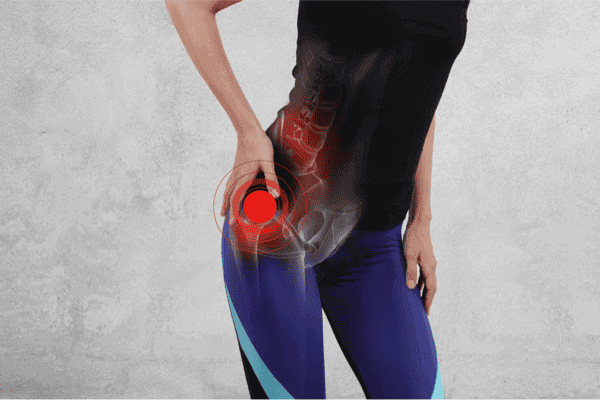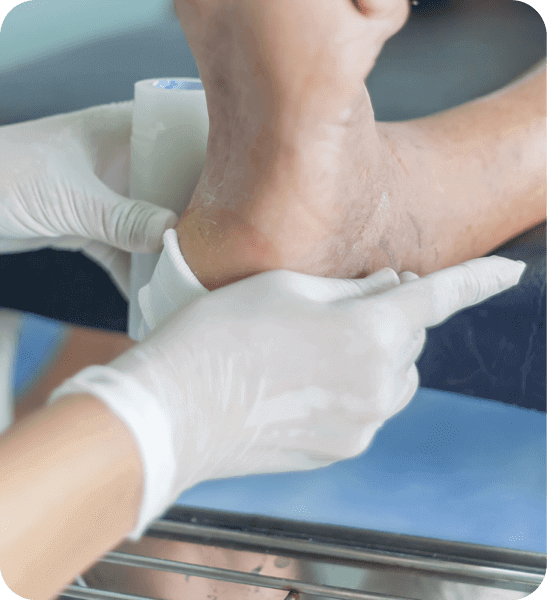Hyperbaric Oxygen Therapy for Post-Surgical Healing
Evidence-Based Adjunctive Treatment for Enhanced Surgical Outcomes
Clinical Overview
Hyperbaric oxygen therapy (HBOT) represents a valuable adjunctive treatment modality for enhancing post-surgical healing outcomes. By delivering 100% oxygen at pressure (typically 2.0-2.5 ATA), HBOT significantly increases dissolved oxygen in plasma, enhancing oxygen delivery to compromised tissues and promoting optimal wound healing environments.
Many of our surgeon partners refer patients to us both pre- and post-surgically. They refer patients pre-surgically to help improve pre-surgical tissue condition, reduce the risk of infection and improve healing outcomes. They refer patients post-surgically to accelerate the healing process and address incisions that present challenges in healing, including on radiation-damaged tissue.
Key Clinical Benefits: HBOT addresses the fundamental pathophysiology of impaired wound healing by correcting tissue hypoxia, stimulating angiogenesis, enhancing fibroblast proliferation, and optimizing immune function. This multi-modal approach can significantly improve surgical outcomes while reducing complications.
HBOT essentially gives the body's natural healing processes a significant boost when normal recovery isn't progressing as expected or when complications arise that threaten the surgical outcome.

Clinical Overview
Hyperbaric oxygen therapy (HBOT) represents a valuable adjunctive treatment modality for enhancing post-surgical healing outcomes. By delivering 100% oxygen at pressure (typically 2.0-2.5 ATA), HBOT significantly increases dissolved oxygen in plasma, enhancing oxygen delivery to compromised tissues and promoting optimal wound healing environments.
Many of our surgeon partners refer patients to us both pre- and post-surgically. They refer patients pre-surgically to help improve pre-surgical tissue condition, reduce the risk of infection and improve healing outcomes. They refer patients post-surgically to accelerate the healing process and address incisions that present challenges in healing, including on radiation-damaged tissue.
Key Clinical Benefits: HBOT addresses the fundamental pathophysiology of impaired wound healing by correcting tissue hypoxia, stimulating angiogenesis, enhancing fibroblast proliferation, and optimizing immune function. This multi-modal approach can significantly improve surgical outcomes while reducing complications.
HBOT essentially gives the body's natural healing processes a significant boost when normal recovery isn't progressing as expected or when complications arise that threaten the surgical outcome.
How Hyperbarics Helps
Mechanisms of Action
Enhanced Oxygen Delivery
Increases plasma oxygen content by 15-20 fold, ensuring adequate tissue oxygenation even in areas with compromised vascular supply, preventing wound dehiscence.
Angiogenesis Stimulation
Promotes formation of new blood vessels through VEGF upregulation and endothelial cell proliferation, improving long-term tissue viability.
Collagen Synthesis
Enhances fibroblast activity and collagen production, leading to improved tensile strength and structural integrity of healing tissues. Helps prevent keloid formation when skin edges don't approximate properly.
Antimicrobial Effects
Creates hyperoxic environment hostile to anaerobic pathogens while enhancing neutrophil bacterial killing capacity. Particularly beneficial for immunocompromised patients including those with autoimmune diseases (SLE, MS), HIV, transplant patients, and diabetics.
Anti-Inflammatory Response
Modulates inflammatory cascade, reducing excessive inflammation while preserving necessary healing responses.
Stem Cell Mobilization
Increases circulating stem cells and progenitor cells, enhancing the body's natural repair mechanisms.
What the Research Says
Clinical Evidence & Outcomes
Randomized Controlled Trials
Multiple RCTs demonstrate significant improvement in wound healing rates, reduced infection rates, and decreased time to complete healing when HBOT is used as adjunctive therapy.
Meta-Analysis Data
Systematic reviews show consistent benefits across various surgical specialties, with particular efficacy in high-risk patient populations.
Clinical Outcomes:
• 65% reduction in healing time
• 40% decrease in infection rates
• 50% reduction in reoperation rates
• 30% improved cosmetic outcomes
Clinical Indications
Surgeons who refer patients to us refer patients with the following concerns:
Compromised Surgical Sites: Wounds with poor vascular supply, tension, or signs of delayed healing; prevention of wound dehiscence
High-Risk Patients: Diabetic patients, immunocompromised individuals (HIV, autoimmune diseases like SLE/MS, transplant patients), elderly patients
Complex Reconstructive Surgery: Flap procedures, tissue grafts, extensive soft tissue reconstruction
Radiation-Damaged Tissue: Surgery in previously irradiated fields with compromised healing potential
Orthopedic Procedures: Complex fractures, nonunions, osteomyelitis treatment
Cardiac Surgery: Heart surgery, CABG procedures, valve replacements
Urological Surgery: Prostate surgery, complex urological reconstructions
Gastrointestinal Surgery: Anastomotic healing, particularly in high-risk colorectal procedures
Patient Selection Criteria
Optimal Candidates
• High-risk surgical patients
• Diabetic patients undergoing surgery
• Patients with peripheral vascular disease
• Immunocompromised individuals (HIV, SLE, MS, transplant patients)
• Previous radiation therapy patients
• Complex reconstructive procedures
• Smokers (with cessation counseling)
• Age >65 with multiple comorbidities
Relative Contraindications
• Untreated pneumothorax
• Severe COPD with CO2 retention
• Uncontrolled seizure disorder
• Claustrophobia (relative)
• Current chemotherapy (consult oncology)
• Pregnancy (limited data)
• Concurrent bleomycin therapy
Timing & Integration with Surgical Care
Optimal Timing
Pre-operative: 2 to 5 sessions generally. For high-risk patients or those with compromised tissue perfusion, from 5 to 10 sessions. For patients with osteomyelitis, the recommendation is 20 sessions prior to surgery.
Post-operative: Initiate within 24-48 hours when medically stable. Earlier initiation generally correlates with better outcomes.
Combined approach: Pre-conditioning followed by post-operative treatment shows superior results in complex cases.
Integration with Standard Care: HBOT serves as an adjunct to, not replacement for, standard wound care practices. Optimal outcomes are achieved when combined with appropriate surgical technique, infection control, nutritional optimization, and comprehensive wound management protocols.
Cost-Effectiveness & Insurance Coverage
Economic Benefits
While HBOT represents an additional treatment cost, studies demonstrate significant cost savings through reduced hospital stays, fewer complications, decreased reoperation rates, and faster return to work. The cost-effectiveness is particularly pronounced in high-risk patient populations.
Insurance Coverage
Medicare and most commercial insurers cover HBOT for approved indications including:
• Diabetic lower extremity wounds
• Compromised skin grafts/flaps
• Chronic refractory osteomyelitis
• Osteoradionecrosis
• Necrotizing soft tissue infections
Referral Process & Collaboration
Bay Area Hyperbarics works closely with referring physicians to ensure seamless patient care coordination. Our medical team provides regular progress reports and maintains open communication throughout the treatment course.
Research Studies
Efficacy of hyperbaric oxygen therapy for diabetic foot ulcer, a systematic review and meta-analysis of controlled clinical trials
Efficacy of hyperbaric oxygen therapy for diabetic foot ulcer, a systematic review and meta-analysis of controlled clinical trials
Studies have suggested that hyperbaric oxygen therapy (HBOT) is effective in the healing of diabetic foot ulcer (DFU); however, there is a lack of consensus. Therefore, to assess the efficacy of HBOT on diabetic foot ulcer among diabetic patients, controlled clinical trials were searched through PubMed, EMBASE, Clinical key, Ovid Discovery, ERMED, Clinical Trials.gov databases for randomized controlled trials (RCTs) and other sources until 15 September 2020.
HBOT Improves Symptoms and Quality of Life in Breast Cancer Patients with Radiation-Induced Toxicities
Application of wound healing management algorithms in hyperbaric oxygen therapy improve clinical outcomes and, at the same time, markedly reduce expenditures.
HBOT Improves Symptoms and Quality of Life in Breast Cancer Patients with Radiation-Induced Toxicities
Oxygen plays key nutritional and “cell signal” roles across the many phases of wound healing: hypoxia is a common etiology in wounds that fail to respond to standard management within anticipated time lines, and hyperbaric doses of oxygen are known to increase hypoxic wound oxygen tensions to normal, even supraphysiologic levels. If HBO therapy is to be effective, therefore, prospective demonstration of hypoxia is critical.
Hyperbaric oxygen therapy as a neuromodulatory technique: a review of the recent evidence
Hyperbaric oxygen therapy as a neuromodulatory technique: a review of the recent evidence
Physicians: Refer a Patient
You Submit Your Patient’s Information
We Get Authorizations
Patient Starts HBOT

Patient Experiences
-

Lisa, 44
After seven years of suffering, hyperbaric oxygen therapy healed her osteomyelitis.
Lisa St John, the clinic director for Bay Area Hyperbarics, had chronic refractory osteomyelitis that lasted seven years with no relief. The infection induced severe fatigue and cognitive impairment that prevented her from working, and required her to sleep up to 18 hours per day. Finally, a physician recommended hyperbaric oxygen therapy with antibiotics, which after 60 treatments, healed her. Shortly after being healed, she sold her home to begin her first hyperbaric oxygen therapy clinic, which she has owned for almost 25 years!
-

Jennifer, 68
Hyperbaric oxygen therapy eliminated the need for surgery to heal her bone infection.
Jennifer had osteomyelitis of the lower jaw (mandible), which proved difficult to heal. Her teeth were becoming loose, and her doctor thought she would need surgery. However, he prescribed hyperbaric oxygen therapy before the surgery, and after 60 treatments, her chronic refractory osteomyelitis healed completely, regrowing bone in her mandible. Jennifer was able to keep her teeth, and was able to return to her active lifestyle, hiking regularly with her husband.
Related Articles
Research on Hyperbaric Oxygen Therapy
-
What is Hyperbaric Oxygen Therapy?
Hyperbaric oxygen therapy treats medical conditions with 100% oxygen in a pressurized hyperbaric chamber. The patient lies or sits in the chamber. The oxygen then saturates the plasma in the blood, allowing oxygen to easily flow throughout the body and reach even areas that are injured or diseased, which typically receive less oxygen. The mechanisms of hyperbaric oxygen therapy include stimulating and mobilizing stem cells, down-regulating inflammatory genes, up-regulating reproductive cells and stimulating DNA. HBOT also regrows tiny blood vessels, and stimulates the growth of new healthy cells in the brain, bones, skin, organs, and tissues. People seek hyperbaric oxygen therapy to heal physical damage in their bodies and to promoting health and anti-aging.
-
Does HBOT kill cancer cells?
Current research indicates that hyperbaric oxygen does not kill cancer cells. However, there has been a small amount of research indicating that hyperbaric oxygen might reduce the size of certain tumors. Also, there has been a study on mice using hyperbaric oxygen, along with a ketogenic diet, to reduce tumors. Hyperbaric oxygen causes many different healing modalities to kick into gear. Could its effect on strengthening the immune system inhibit the growth of cancer cells? Nobody knows. There are numerous studies conclusively showing that hyperbaric oxygen does not encourage cancer cells or tumors to grow. Some patients claim the hyperbaric oxygen makes them feel a lot more comfortable and functional after chemotherapy and also during healing. Note that some chemotherapy drugs are not to be used with hyperbaric oxygen, as the chemotherapy drugs can be enhanced and thus become toxic. A good hyperbaric oxygen facility (such as Bay Area Hyperbarics) will always call the chemotherapy manufacturer to ensure that hyperbaric oxygen therapy will be helpful and not damaging to the patient.
-
IWhat is the CPT code for HBOT?
The CPT code for HBOT is G0277.
-
Does Medicare cover HBOT?
Medicare covers Hyperbaric Oxygen Therapy for approved conditions, and many insurance companies also cover approved conditions. If your condition is not approved by your insurance, we can discuss our special rates. Give us a call at (408) 356–7438. We are happy to discuss your options with you.
-
Can HBOT help Neuropathy?
Hyperbaric treatments help heal neuropathy by regrowing small blood vessels and nerves that have died from disease, injuries from radiation and aging. Patients often experience numbness and or pain when they start treatment. Hyperbaric treatments most often bring back sensation and make, for example, walking easier and more enjoyable.
-
Why would a physician consider HBOT?
A physician would consider using hyperbaric chamber therapy under a variety of situations. Physicians most typically refer patients to hyperbarics when the patient is not healing with traditional medical interventions and hyperbaric chamber therapy is approved by Medicare for this condition. Some patients experience significant unresolved pain and unremitting disease states that the mechanisms of hyperbaric oxygen therapy in a hyperbaric chamber are known to affect, such as the down regulation of inflamatory genes. For an example, some patients have experienced severe, unremitting hives with itching, which did not improve with any specialists interventions. Some physicians will consider hyperbaric chamber therapy if the patient has no other good avenues for improving their failing health, and they know the hyperbaric chamber therapy is safe and will not harm the patient.
-
What is Hypebaric Oxygen Therapy?
Hyperbaric Oxygen Therapy (HBOT) Hyperbaric Oxygen Therapy (HB0T) is a medical treatment where you inhale 100% oxygen in a chamber with increased atmospheric pressure. HBOT injects 400x the oxygen into your tissues and bones and mobilizes stem cells. It regrows healthy tissues in the brain, blood vessels, skin and bones. It also reduces pain and swelling, and speeds recovery. It is simple, effective and painless.
Have more Questions?




